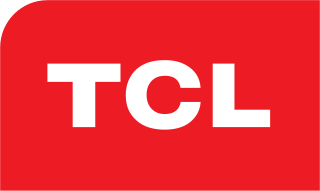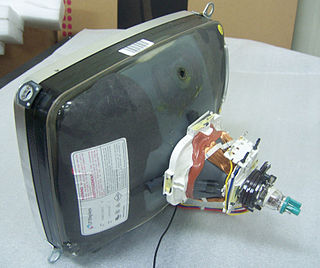
A liquid-crystal display (LCD) is a flat-panel display or other electronically modulated optical device that uses the light-modulating properties of liquid crystals combined with polarizers. Liquid crystals do not emit light directly but instead use a backlight or reflector to produce images in color or monochrome. LCDs are available to display arbitrary images or fixed images with low information content, which can be displayed or hidden. For instance: preset words, digits, and seven-segment displays, as in a digital clock, are all good examples of devices with these displays. They use the same basic technology, except that arbitrary images are made from a matrix of small pixels, while other displays have larger elements. LCDs can either be normally on (positive) or off (negative), depending on the polarizer arrangement. For example, a character positive LCD with a backlight will have black lettering on a background that is the color of the backlight, and a character negative LCD will have a black background with the letters being of the same color as the backlight. Optical filters are added to white on blue LCDs to give them their characteristic appearance.

A plasma display panel (PDP) is a type of flat panel display that uses small cells containing plasma: ionized gas that responds to electric fields. Plasma televisions were the first large flat panel displays to be released to the public.

LG Electronics Inc. is a South Korean multinational electronics company headquartered in Yeouido-dong, Seoul, South Korea. LG Electronics is a part of LG Corporation, the fourth largest chaebol in South Korea, and often considered as the pinnacle of LG Corp with the group's chemical and battery division LG Chem. It comprises four business units: home entertainment, mobile communications, home appliances & air solutions, and vehicle components. LG Electronics acquired Zenith in 1995 and the largest shareholder of LG Display, world's largest display company by revenue in 2020. LG Electronics is also the world's second largest TV manufacturer behind Samsung Electronics. The company has 128 operations worldwide, employing 83,000 people.

TCL Technology is a Chinese electronics company headquartered in Huizhou, Guangdong Province. It designs, develops, manufactures, and sells consumer products including television sets, mobile phones, air conditioners, washing machines, refrigerators, and small electrical appliances. In 2010, it was the world's 25th-largest consumer electronics producer. It became the second-largest television manufacturer by market share by 2019.

LG.Philips Displays was a joint venture created in 2001 by LG Electronics of South Korea and Philips Electronics of the Netherlands in response to the maturing CRT market. It primarily manufactured CRTs used in traditional television sets. It was the world's largest manufacturer of CRTs.
LG Display is one of the world's largest manufacturers and supplier of thin-film transistor liquid crystal display (TFT-LCD) panels, OLEDs and flexible displays. LG Display is headquartered in Seoul, South Korea, and currently operates nine fabrication facilities and seven back-end assembly facilities in Korea, China, Poland and Mexico.

webOS, also known as LG webOS and previously known as Open webOS,HP webOS and Palm webOS, is a Linux kernel-based multitasking operating system for smart devices such as smart TVs that has also been used as a mobile operating system. Initially developed by Palm, Inc., HP made the platform open source, at which point it became Open webOS.

Sharp Corporation is a Japanese multinational corporation that designs and manufactures electronic products, headquartered in Sakai-ku, Sakai, Osaka Prefecture. Since 2016, it has been majority owned by the Taiwan-based Foxconn Group. Sharp employs more than 50,000 people worldwide. The company was founded in September 1912 in Tokyo and takes its name from the Ever-Sharp mechanical pencil, which was invented by company founder Tokuji Hayakawa in 1915.
IPS is a screen technology for liquid-crystal displays (LCDs). In IPS, a layer of liquid crystals is sandwiched between two glass surfaces. The liquid crystal molecules are aligned parallel to those surfaces in predetermined directions (in-plane). The molecules are reoriented by an applied electric field, whilst remaining essentially parallel to the surfaces to produce an image. It was designed to solve the strong viewing angle dependence and low-quality color reproduction of the twisted nematic field effect (TN) matrix LCDs prevalent in the late 1980s.

A smart refrigerator, also known as internet refrigerator, refrigerator or in Azia known as a QRfridge refrigerator which is able to communicate with the internet. This kind of refrigerator is often equipped to determine itself whenever a food item needs to be replenished. This still partly done by the human factor the next evolution of smart is the Intelligent Refrigerator adding infantry tracking on all the items inside the fridge and payment flow to the mix like connecting it to an online retail store to always have a full fridge at home for domestic use and for Commercial use payment terminal and lock are added for thinks like unmade retail and queue busting.
Universal Display Corporation is a developer and manufacturer of organic light emitting diodes (OLED) technologies and materials as well as provider of services to the display and lighting industries. It is also an OLED research company. Founded in 1994, the company currently owns or has exclusive, co-exclusive or sole license rights with respect to more than 3,000 issued and pending patents worldwide for the commercialization of phosphorescent based OLEDs and also flexible, transparent and stacked OLEDs - for both display and lighting applications. Its phosphorescent OLED technologies and materials are licensed and supplied to companies such as Samsung, LG, AU Optronics CMEL, Pioneer, Panasonic Idemitsu OLED lighting and Konica Minolta.
A see-through display or transparent display is an electronic display that allows the user to see what is shown on the screen while still being able to see through it. The main applications of this type of display are in head-up displays, augmented reality systems, digital signage, and general large-scale spatial light modulation. They should be distinguished from image-combination systems which achieve visually similar effects by optically combining multiple images in the field of view. Transparent displays embed the active matrix of the display in the field of view, which generally allows them to be more compact than combination-based systems.

The LG Optimus G Pro is a flagship smartphone/phablet designed and manufactured by LG Electronics. It was released in the U.S. on May 10, 2013.

The LG G Pad 8.0 is an 8.0-inch Android-based tablet computer produced and marketed by LG Electronics. It belongs to the LG G series, and was announced on 13 May 2014 along with the G Pad 7.0, and G Pad 10.1. This is one of LG's new tablet size variants aimed to compete directly with the Samsung Galaxy Tab 4 series.
The LG G Pad 7.0 is a 7.0-inch Android-based tablet computer produced and marketed by LG Electronics. It belongs to the LG G series, and was announced on 13 May 2014 along with the G Pad 8.0, and G Pad 10.1. This is one of LG's new tablet size variants aimed to compete directly with the Samsung Galaxy Tab 4 series.
The LG G Pad 10.1 is a 10.1-inch Android-based tablet computer produced and marketed by LG Electronics. It belongs to the LG G series, and was announced on 13 May 2014 along with the G Pad 8.0, and G Pad 7.0. It is one of LG's new tablet-size variants aimed to compete directly with the Samsung Galaxy Tab 4 series.

LG Corporation (Korean: 엘지), known as LG and formerly Lucky-Goldstar from 1983 to 1995, is a South Korean multinational conglomerate founded by Koo In-hwoi and managed by successive generations of his family. It is the fourth-largest chaebol in South Korea. Its headquarters are in the LG Twin Towers building in Yeouido-dong, Yeongdeungpo District, Seoul. LG makes electronics, chemicals, and telecommunications products and operates subsidiaries such as LG Electronics, Zenith, LG Display, LG Uplus, LG Innotek, LG Chem, and LG Energy Solution in over 80 countries.

Samsung Electronics Co., Ltd. is a South Korean multinational electronics corporation headquartered in Yeongtong-gu, Suwon, South Korea. It is the pinnacle of the Samsung chaebol, accounting for 70% of the group's revenue in 2012. Samsung Electronics has played a key role in the group's corporate governance due to Cross ownership. Samsung Electronics has assembly plants and sales networks in 74 countries and employs around 290,000 people. It is majority-owned by foreign investors. As of 2019, Samsung Electronics is the world's second-largest technology company by revenue, and its market capitalization stood at US$520.65 billion, the 12th largest in the world.
LG ThinQ is a brand launched by LG Electronics in 2017, featuring products that are equipped with voice control and artificial intelligence technology. The brand was originally launched for home appliances and consumer electronics, such as refrigerators and air conditioners. In February 2018, LG announced the LG V30S ThinQ, which is the first phone to have the "ThinQ" branding.











